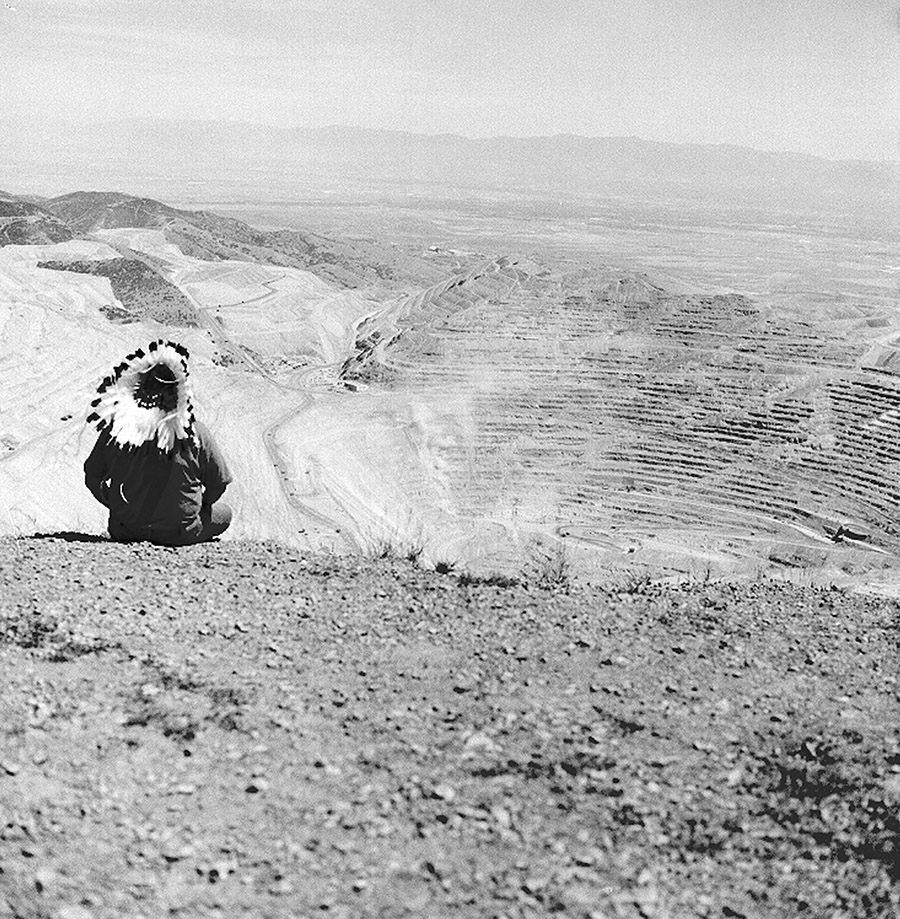
Zig Jackson, Kennecott Copper Mine, Tooele, Utah
Zig Jackson
1957-
Mandan/Hidatsa/Arikara
Alternative Name
Rising Buffalo
Date
2000
Medium Specific
Gelatin silver print
Classification
Photograph
Dimensions
16 x 19 1/2 in. (40.6 x 49.5 cm)Framed: 21 x 25 in. (53.3 x 63.5 cm)
Accession Number
2020.20.10.13
Credit
Gift of the Artist
Memo / Artist Statement
As a native artist in contemporary America, I intend my work to be both provocative and educational – carrying an especially urgent message. In one sense, it is intensely personal; yet, in another – by virtue of my background and native roots, as part of an Indigenous group struggling for autonomy in the shadow of a dominant one – my work cannot escape an implicit politicism. Dealing with a culture in transition and its fight to survive within the confines of a foreign social structure and economic framework, my imagery explores the inherent ironies engendered by the confrontation of two opposing cultures and belief systems – including contemporary issues of identity and representation, displacement, land rights, Indigenous sovereignty, and the ambiguity of cultural boundaries.
In today’s world, we are inundated with images of Indians in the media, Hollywood, and contemporary consumer society; yet the Native American remains an enigma. The subject of legend and popular fantasy, s/he is commonly viewed as an ageless anachronism forever frozen in the past, as exemplified by tired and hackneyed characterizations such as the “Noble Savage”, the stoic and ruthless warrior, the nubile, buckskin-clad maiden, the all-knowing shaman and spiritual guru, etc. Even today, after centuries of coexistence, the real Indian remains an elusive paradox to the majority of non-native society.
As an Indian artist, I feel a responsibility to deconstruct the pervasive myths and misconceptions about Native Americans, in order to reveal more accurate and informed representations. I use my art as a means of de-mythologizing my own history and breaking down the prevailing stereotypes, social constructs, paternalistic attitudes, and romanticized images perpetuated by popular media and folklore.
In contrast to the seductive and glamorized (or alternatively, demonized) caricatures that thrive in Hollywood and the collective American imagination, my images reveal a far different reality – one of people in transition, a traditional Indigenous culture desperately struggling to survive in the midst of a rapidly changing technological society. Attempting to counteract centuries of entrenched bias and misrepresentation, I use photography to document the everyday life experience of today’s Indian, at once bringing a human face to contemporary Native America, while revealing the underlying issues and obstacles which incessantly plague us, undermining the very fabric of our culture and threatening our continued existence as people.
April, 2006
In today’s world, we are inundated with images of Indians in the media, Hollywood, and contemporary consumer society; yet the Native American remains an enigma. The subject of legend and popular fantasy, s/he is commonly viewed as an ageless anachronism forever frozen in the past, as exemplified by tired and hackneyed characterizations such as the “Noble Savage”, the stoic and ruthless warrior, the nubile, buckskin-clad maiden, the all-knowing shaman and spiritual guru, etc. Even today, after centuries of coexistence, the real Indian remains an elusive paradox to the majority of non-native society.
As an Indian artist, I feel a responsibility to deconstruct the pervasive myths and misconceptions about Native Americans, in order to reveal more accurate and informed representations. I use my art as a means of de-mythologizing my own history and breaking down the prevailing stereotypes, social constructs, paternalistic attitudes, and romanticized images perpetuated by popular media and folklore.
In contrast to the seductive and glamorized (or alternatively, demonized) caricatures that thrive in Hollywood and the collective American imagination, my images reveal a far different reality – one of people in transition, a traditional Indigenous culture desperately struggling to survive in the midst of a rapidly changing technological society. Attempting to counteract centuries of entrenched bias and misrepresentation, I use photography to document the everyday life experience of today’s Indian, at once bringing a human face to contemporary Native America, while revealing the underlying issues and obstacles which incessantly plague us, undermining the very fabric of our culture and threatening our continued existence as people.
April, 2006
Biography
As a native artist in contemporary America, Jackson intended his work to be both provocative and educational - carrying an especially urgent message. In one sense, it is intensely personal; yet, in another -by virtue of his background and native roots, as part of an indigenous group struggling for autonomy in the shadow of a dominant one - Jackson’s work cannot escape an implicit politicism. Dealing with a culture in transition and its fight to survive within the confines of a foreign social structure and economic framework, his imagery explores the inherent ironies engendered by the confrontation of two opposing cultures and belief systems—including contemporary issues of identity and representation, displacement, land rights, indigenous sovereignty, and the ambiguity of cultural boundaries.
Jackson’s primary education comes from the government Indian boarding school systems. It was at St. Joseph's Indian School in Chamberlain, South Dakota that he initially received formal training in sketching and painting. For his secondary education, Jackson went to the Intermountain Indian School in Brigham City, Utah—where he first picked up a camera. There Jackson gained an awareness of all Native American needs and problems—such as poverty, alcoholism, and suicide, realizing that all Indian people are confronted with the same obstacles.
Jackson’s primary education comes from the government Indian boarding school systems. It was at St. Joseph's Indian School in Chamberlain, South Dakota that he initially received formal training in sketching and painting. For his secondary education, Jackson went to the Intermountain Indian School in Brigham City, Utah—where he first picked up a camera. There Jackson gained an awareness of all Native American needs and problems—such as poverty, alcoholism, and suicide, realizing that all Indian people are confronted with the same obstacles.
